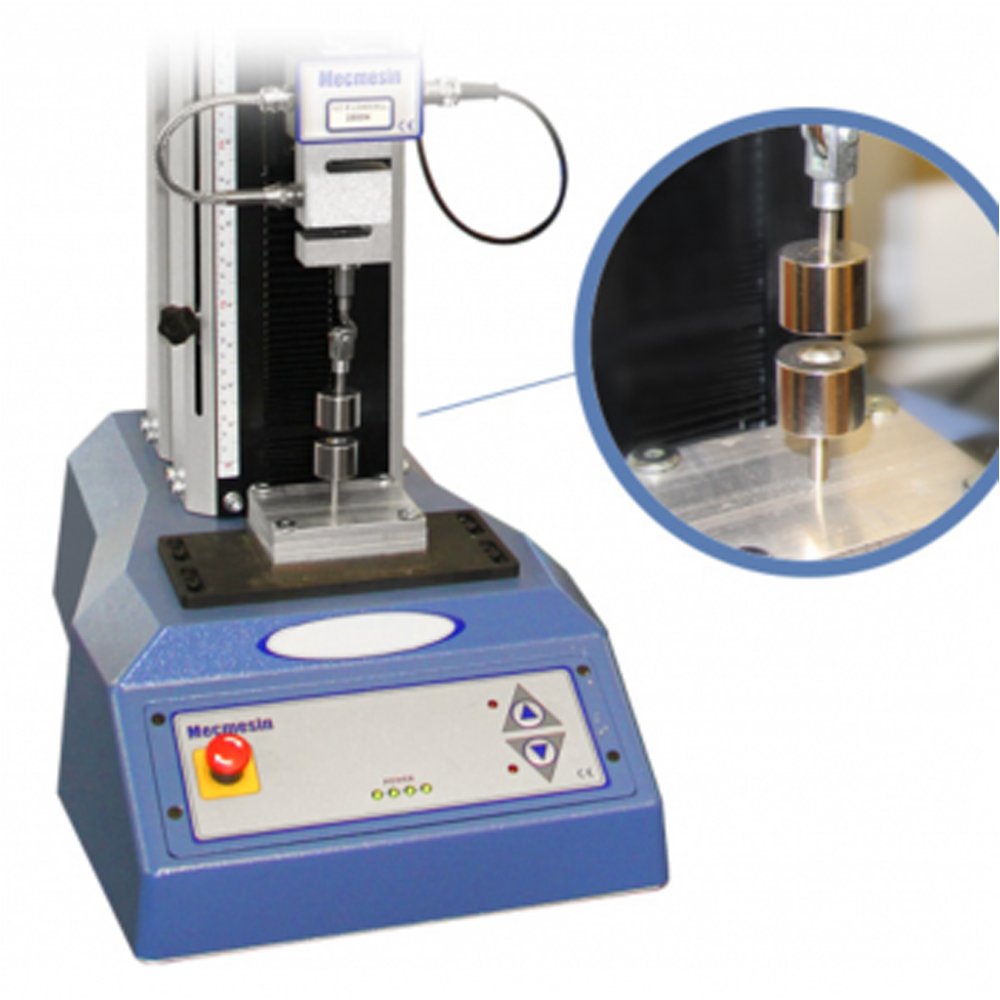A
Air gap
An ‘air gap’ is a non-magnetic material, which is present between a magnet and an attracted object or between two magnets that are attracting each other creating a break in the magnetic circuit, which magnetism has to jump through to continue a circuit between the north and south poles.
The introduction of an air gap weakens the magnetic hold.
Anisotropic
A magnet is described as anisotropic if all of its magnetic domains are aligned in the same direction, this is achieved during the manufacturing process and ensures that the domains are 100% orientated in the same direction to deliver maximum magnetic output.
Axially magnetised
The term axially magnetised describes a magnet that is magnetised between two flat parallel surfaces.
B
B-H curve (magnetic flux density-magnetic field curve)
Sometimes referred to as the ‘magnetisation curve’ or ‘demagnetisation curve’, the B-H curve is a graphical representation showing the relationship between ‘magnetic flux density (B) and the ‘magnetic field strength’ (H) required to demagnetise a specific magnet.
C
Closed circuit
A closed magnetic circuit describes an arrangement of magnetic and ferrous material which directly connects the north pole of a magnet to the south. In a closed-circuit the lines of magnetic flux are allowed to flow freely from north to south and all of the magnetic flux density is retained within the closed circuit.
Coercivity
The coercivity of a magnetic field is the intensity, or energy, required to reduce the magnetisation of a magnetised (to the point of saturation) object to zero. Essentially, it measures a magnetic material’s resistance to demagnetisation. The coercivity of magnetic material is measured in Oersteds (Oe) – the higher the number, the greater the magnet’s resistance to demagnetisation.
Curie temperature
The properties of all magnetic materials change when they are heated to a particular temperature. The Curie temperature (Tc), or Curie point, is the temperature at which the atomic structure of magnetic material is changed and the object becomes demagnetised.
D
Demagnetisation
Demagnetisation occurs when a magnet loses its external magnetic field when in open circuit.
Density
Density is a measurement of a materials mass per unit of volume.
Diamagnetic
Diamagnetism is a kind of magnetism that aligns itself at right-angles to the direction of an objects magnetic field and therefore has a repellent force.
Diametrically magnetised magnets
Cylindrical magnets are described as diametrically magnetised when their direction of magnetism is parallel to the diameter of the magnet, rather than perpendicular to the flat faces of the cylinder.
Direction of magnetisation
Magnets can be specified and ordered to be magnetised across any axis, allowing them to be used to different effect. The direction of magnetism determines which side of the magnet the north and south poles appear.
E
Electromagnet
Unlike permanent magnets, the magnetic field exerted by an electromagnet is produced by the flow of electric current. The magnetic field disappears when the current is turned off.
F
Ferromagnetism
Ferromagnetism is the strongest form of magnetism and is the only form that creates forces so strong that they can be noticed by human hands. A ferromagnetic substance is strongly attracted by a magnet.
Flux
Magnetic flux is the number of lines of magnetism travelling from a magnetic pole. The CGS unit of measurement for ‘flux’ is Maxwells and the SI unit is Webers.
Flux density
Flux density describes the number of lines of magnetism in each square centimetre of pole area.
G
Gauss
Named after the famous German mathematician and physicist Carl Friedrich Gauss, the Gauss is a unit of measurement for magnetic flux density. 1,000 Gauss is 1,000 lines of magnetism in each cm2 of pole area.
Gauss meter
A gauss meter is used to measure the flux density (Gauss) of a magnet.
H
Homogeneous field
A homogenous magnetic field is one where the lines of the magnetic field are uniform, creating an equal force/current in all places within the field.
Hysteresis loop
A four-quadrant graph, showing magnetising force relative to the resultant magnetisation of a permanent magnet material as it is successively magnetised to its saturation point, then demagnetised, magnetised in the reverse polar direction and then finally re-magnetised.
I
Induction, (B)
Magnetic induction, also known as flux density is the number of lines of magnetism in each square centimetre of pole area.
Intrinsic coercivity (Hci)
If the coercivity of a magnet is the force required to cancel out a saturated magnet’s magnetic field, the intrinsic coercivity is the force required to permanently demagnetise a magnet.
Isotropic
A magnet made of magnetically isotropic material has no preferred direction of magnetism and has the same properties along either axis. During manufacture, isotropic material can be manipulated so that the magnetic field is applied in any direction.
K
Keeper
A keeper is a steel bar or disc placed between and attached to opposite poles of a magnet to allow all the magnetism to flow from one pole to the other. The keepered magnet will appear completely non-magnetic until the keeper is removed.
M
Magnetic axis
In an anisotropic magnet, all of the magnet’s magnetic domains are aligned to face the same way. The line of direction that the domains follow is called the magnetic axis.
Magnetic circuit
All magnetism flows from north to south and a magnetic circuit is a journey that it takes to get from north to south.
Magnetic field strength (H-field)
Magnetic field strength is the measure of a magnetising field originating from an electrical current or a permanent magnet.
Magnetic induction (B-field)
Magnetic induction, also known as flux density is the number of lines of magnetism in each square centimetre of pole area.
Magnetisation (M)
Magnetisation refers to an object producing a magnetic field.
Magnetised
A material or magnet is defined as magnetised when it exerts a magnetic field, either because of its interaction with an electromagnet or another permanent magnet.
Magnetomotive force (mmf)
Magnetomotive force is the magnetic field produced by a coil of wire when current is passed through it.
Material
The term material refers to the physical composition of a magnet.
Maximum energy product (BHmax)
The maximum energy product of a magnet is measured in ‘Mega-Gauss Oersteds’ (MGOe). Known as the maximum energy product value, this is the primary indicator of a magnet’s ‘strength’.
Maximum Operating Temperature (Tmax)
The maximum operating temperature is exactly as it sounds, it represents the maximum temperature that a particular grade that a magnet will be able to function at before it becomes permanently demagnetised.
O
Oersted
The Oersted (Oe) is a measure of magnetic field strength and is closely related to the Gauss measurement for flux density and is used to measure external electromagnetic forces usually produced in magnetisers and demagnetisers.
Open circuit
A magnet is said to be in an open circuit when it is not attached to any other ferrous material, meaning that its lines of magnetic flux make their way from the north pole to the south pole through the air alone, rather than through a ferromagnetic material.
P
Permeability
Some materials, when placed inside a magnetic field, become magnetised themselves. The permeability of a magnetic substance represents the increase or decrease of the magnetic field inside the substance compared to the magnetising field that the substance is located within.
Permanent magnet
A permanent magnet is a solid material that produces its own consistent magnetic field because the material is magnetised.
Plating
Plating is another term for coating. Platings or coatings are applied to raw neodymium magnets to prevent corrosion and demagnetisation.
Pole
The pole of a magnet is the area of a magnet which has the greatest magnetic field strength in a given direction. Each pole is either north facing or south facing.
Pull-gap curve
A pull-gap curve plots the ‘pulling power’ of a magnet in direct contact with a thick and flat piece of steel and then though a steadily increasing range of air gaps. Pull follows an inverse square law relationship with distance.
Pull strength
The pull strength is the highest possible holding power of a magnet, measured in kilograms. It is the force required to prise a magnet away from a flat surface of steel when the magnet and metals have full and direct surface-to-surface contact.
R
Remanence (Br)
Remanence is described as the magnetism that is left in a magnet, after the removal of the external magnetic force applied to magnetise it.
Repelling
When two magnets are placed close together with the same poles facing each other, e.g. north facing north or south facing south, they will always repel one another.
S
Stacking
Stacking refers to the process of placing magnets together to increase the net pull strength.
Surface Field / surface gauss
The surface field strength is measured in Gauss and is the magnet’s maximum field strength taken from the magnet’s pole surface.
T
Temperature coefficient (T)
Temperature coefficient is a factor that is used to calculate the decrease in magnetic flux corresponding to an increase in operating temperature.
Tesla (T)
The Tesla is a unit of measurement for magnetic flux density.
Thread
Some magnets are manufactured to include a thread for fixing in their applications.
W
Weight
Weight refers to the weight of one single magnet made of magnetic material.


